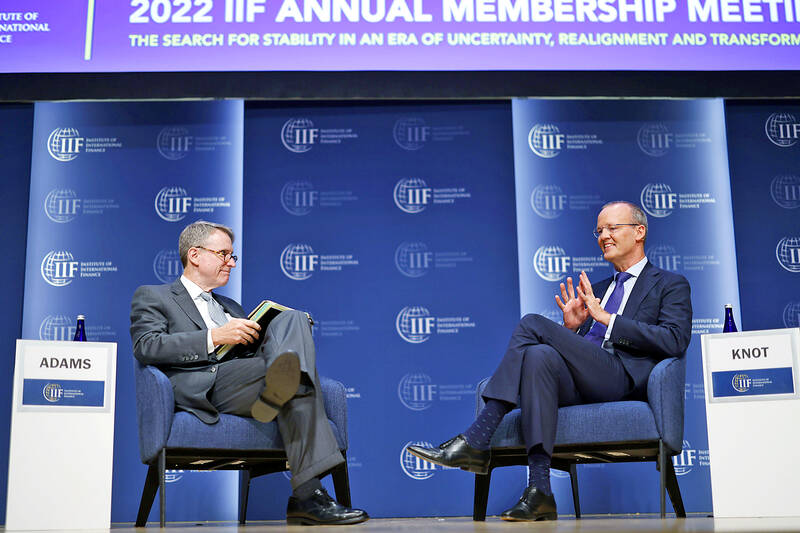Hawkish European Central Bank (ECB) officials aim to start unwinding the institution’s 5.1 trillion euro (US$4.98 trillion) asset hoard by early yesterday while retaining interest rates as their primary monetary-policy tool, people familiar with the matter said.
A consensus is emerging among some Governing Council members that the process of shrinking the balance should run in the background while the ECB focuses on setting borrowing costs, they said, declining to be identified because discussions on the matter are private.
That would require a decision on a framework that could then be revisited after a period of time, the people said.

Photo: Bloomberg
The officials favor letting bonds mature rather than resorting to debt sales, though that option should not be entirely excluded. They could also envisage keeping up some reinvestments to moderate the pace of unwinding.
An ECB spokesperson declined to comment on plans to unwind the balance sheet.
ECB hawks have effectively dictated the momentum of monetary policy since early June, a dominance over decisionmaking that suggests their opinions might well continue to hold sway.
Officials started discussions on a possible strategy for so-called quantitative tightening (QT) last week at a meeting in Cyprus, Central Bank of Luxembourg Governor Gaston Reinesch said in a blog post on Wednesday.
How to begin offloading bonds bought up over several years of stimulus is a highly sensitive matter for the ECB.
Its monetary policy has struggled to stay focused against the distraction of how more restrictive measures might hurt Italy’s debt sustainability.
A blowout in that country’s bond yields in June forced officials to devise a new crisis tool to ensure that they could continue raising interest rates without harming the integrity of the euro region.
The Bank of England’s own confrontation with financial-market turmoil in recent weeks similarly illustrates the dangers of how a plan to reduce bond holdings can go awry.
Dutch central bank President Klaas Knot told Bloomberg Television on Wednesday about how the ECB would want to do things differently from the British central bank.
“They actively have to sell” because of their long-dated portfolio, he said.
“Like in the US, we have bonds over the full maturity, and we think we can do QT by just rolling off existing bonds by less than full reinvestment, which is naturally a smoother process,” he said.
ECB officials are agreed that they should not start shrinking the balance sheet until they reach a level of rates deemed to be neutral — neither stimulating nor constricting the economy.
It is likely that they might do that as soon as December.
“The question arises obviously as to how this which has now been stopped in terms of net asset purchases should be reversed: with which horizon, at which pace,” ECB President Christine Lagarde said on Wednesday. “This is a discussion which we have started and that will be continued.”
The opportune time to begin winding the balance sheet down would be March next year, said David Powell at Bloomberg Economics, who predicts an average reduction of 29 billion euros a month, or just under 1 percent of the size of the combined portfolios of quantitative easing and pandemic emergency bond purchases.
“At that pace, nine to 10 years would be required to offload all of the securities held,” he wrote in a report published yesterday. “The ECB may implement active bond sales to hasten the shrinkage of the balance sheet. That will depend on market conditions and the inflation outlook — we expect the Governing Council to tread cautiously.”

Taiwan’s exports soared 56 percent year-on-year to an all-time high of US$64.05 billion last month, propelled by surging global demand for artificial intelligence (AI), high-performance computing and cloud service infrastructure, the Ministry of Finance said yesterday. Department of Statistics Director-General Beatrice Tsai (蔡美娜) called the figure an unexpected upside surprise, citing a wave of technology orders from overseas customers alongside the usual year-end shopping season for technology products. Growth is likely to remain strong this month, she said, projecting a 40 percent to 45 percent expansion on an annual basis. The outperformance could prompt the Directorate-General of Budget, Accounting and

The demise of the coal industry left the US’ Appalachian region in tatters, with lost jobs, spoiled water and countless kilometers of abandoned underground mines. Now entrepreneurs are eyeing the rural region with ambitious visions to rebuild its economy by converting old mines into solar power systems and data centers that could help fuel the increasing power demands of the artificial intelligence (AI) boom. One such project is underway by a non-profit team calling itself Energy DELTA (Discovery, Education, Learning and Technology Accelerator) Lab, which is looking to develop energy sources on about 26,305 hectares of old coal land in

Netflix on Friday faced fierce criticism over its blockbuster deal to acquire Warner Bros Discovery. The streaming giant is already viewed as a pariah in some Hollywood circles, largely due to its reluctance to release content in theaters and its disruption of traditional industry practices. As Netflix emerged as the likely winning bidder for Warner Bros — the studio behind Casablanca, the Harry Potter movies and Friends — Hollywood’s elite launched an aggressive campaign against the acquisition. Titanic director James Cameron called the buyout a “disaster,” while a group of prominent producers are lobbying US Congress to oppose the deal,

Two Chinese chipmakers are attracting strong retail investor demand, buoyed by industry peer Moore Threads Technology Co’s (摩爾線程) stellar debut. The retail portion of MetaX Integrated Circuits (Shanghai) Co’s (上海沐曦) upcoming initial public offering (IPO) was 2,986 times oversubscribed on Friday, according to a filing. Meanwhile, Beijing Onmicro Electronics Co (北京昂瑞微), which makes radio frequency chips, was 2,899 times oversubscribed on Friday, its filing showed. The bids coincided with Moore Threads’ trading debut, which surged 425 percent on Friday after raising 8 billion yuan (US$1.13 billion) on bets that the company could emerge as a viable local competitor to Nvidia